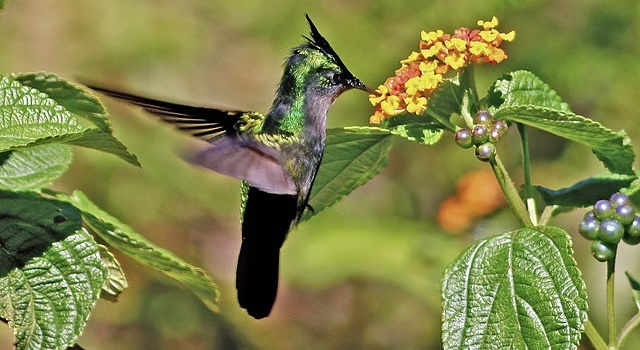Sage advice about the best native plants to attract pollinators to your Mexican garden
News Category: News, Community News, and General Discussion
-
By Glenn Griffin
The importance of birds and insects to our environment, to food production, and to the economy is well known; what isn’t so well known is how we can help these pollinators continue their important roles in nature.
Mexico is the original home to hundreds of different trees, cacti, succulents, annuals, and perennials. I’m sharing my knowledge about eight Mexican perennials, not just because they are excellent plants for pollinators, but because they also look good in a traditional garden. Further, they are reasonably easy to find in viveros, Mexican garden centers.
You can grow one, two, some, or all of these Mexican natives in the ground or in a container. If you’re like me, you’ll get endless pleasure from watching the pollinators visit.
Lantana camara
Mexicans call it cinco negritos (five little blacks), but I don’t know why. Horticulturists call it Lantana camara, perhaps because that’s what they learned in botany class. I just call it lantana, because it’s easy to remember.
I like lantana because it is the easiest to grow of all the native pollinator plants that I’ve had experience with, and it flowers almost constantly. One three- to four-foot-tall shrub can easily have as many as 1,000 flowers, and even in the heart of winter, there’ll be a few blooms. My home is in central Mexico, in San Miguel de Allende, and in the wild, between SMA and Mexico City the flowers are orange and yellow. You’ll also often find white, pink, lavender, and fuchsia forms in garden centers. The fruits that are formed following the flowers are a favorite food of many species of birds, enabling the seeds to be spread for miles.
On my visits to the Audubon de Mexico Pollinator Garden in San Miguel de Allende’s Parque Juarez, I’ve seen more butterflies on lantanas than on any other plant.
Lantana prefers a lot of suns, but doesn’t care much about the type of soil it’s in, as long as it drains well. It can go weeks without watering once it’s established but prefers a good drenching once a week.
The plant grows to about five feet tall, but I like it pruned back to about two feet in early spring so that it fills out and flowers more profusely. In Canada and the northern two-thirds of the US, it’s usually grown as an annual. I don’t recommend growing it out of its native zone, from Mexico through Central and South America, however, as Lantana camara is on the International Union for Conservation of Nature’s list of the 100 most invasive species.
Asclepias curassavica
If you want monarch butterflies to visit, this is the one plant you want. I call it tropical milkweed; other ex-pats call it Mexican butterfly weed; it’s called algodoncillo by Mexicans. Milkweed gets the name Asclepias from the Greek god of healing, and it’s had multiple medicinal uses throughout its history.
Milkweed is a little different from the rest of the pollinator plants I recommend. Its prime role in a pollinator garden is not providing nectar. Milkweed is the only plant in the world where the monarch butterfly will lay eggs; the eggs hatch into caterpillars, and the caterpillars eat the milkweed’s leaves.
Tropical milkweed averages about three feet in height and, with flowers almost identical in color, it works well as a complimentary plant to lantana in a pollinator garden. Like lantana, it also prefers full sun and is quite a drought tolerant.
The one thing I don’t like and you may not like about Asclepias currasavica is that for about three or four months a year when the caterpillars are actively eating them, you might be left with some plants that aren’t much more than sticks.
Though they’re ideal for San Miguel de Allende, I don’t recommend planting tropical milkweed outside the traditional southern habitats of monarchs, as it can confuse their migratory patterns and encourage disease.
Russelia equisetiformis
The internet says this is known as the coral plant or the fountain bush. I know it as the firecracker plant, which I think is far more appropriate, as it just explodes with the color of fire.
I would put this plant into my garden even if it didn’t attract pollinators. With its arching stems, I might put this plant in my garden even if it didn’t flower.
A firecracker plant’s stems grow to about four feet in length and arch to about two feet in height. Though it’s difficult to do, as it may still have flowers, cutting it back almost to the ground in early Spring will give you a fuller and neater plant in the summer.
Though it’s not the tidiest of plants in the ground, it’s a cascading fountain of color in a planter. So, if you don’t have a garden, perhaps only a window box, a hanging basket, or a pot or two, I can’t think of a better way to attract hummingbirds and butterflies.[…]

Most of the plants I’ve featured can be found at the Audubon de Mexico’s Pollinator Garden in San Miguel de Allende’s Parque Juarez.
The small plot of land is an urban oasis for many of central Mexico’s birds, bats, bees, butterflies, and other insects. One of my favorite things to do is to wander around, iPhone in hand, watching for some butterfly with magically painted wings to land, and capture it feeding on pollen before it flutters away.
The park is open from dawn to dusk, seven days a week.
-


Leave a Reply